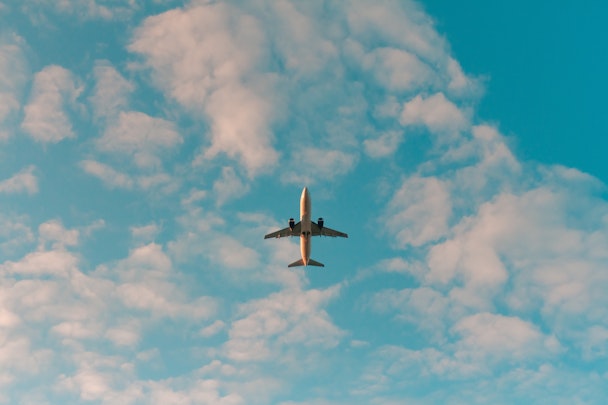What does travel’s return voyage look like?
Travel was hit hard by the pandemic. Lockdowns and other restrictions decimated business for airlines, accommodation providers and countless businesses downstream of the travel industry. Recovery has been slow in the pandemic’s long tail, with continued trepidation now exacerbated by inflation and cost-of-living crises. Many marketers have been closely involved in travel clients’ pivots, survival strategies and (now) regrowth plans. We asked five experts from The Drum Network: what should marketers be thinking of during travel’s return voyage?

What should marketers know as travel takes off again? / Philip Myrtorp via Unsplash
Gemma Flinders, senior digital PR specialist, Impression: staying local
Since the pandemic and now with the current conflict between Ukraine and Russia, there has been more of an emphasis on holidaying in one’s home country: the staycation. Here in the UK, there have been copious campaigns that have highlighted the beauty of our country, suggesting the best places to visit.
With the rising cost of living, staycations are a more affordable option – particularly for families. Renting campervans has had a boom over the past few years due to people not being able to book sold-out staycation accommodation and wanting to take control of their staycation. ‘Rent a campervan near me’ has had a 4050% increase in searches, with Newquay and Inverness being top locations to visit, according to Google trends.
Campaigns around the topic of staycations that seem to be the most effective are index-style campaigns, using multiple factors to give the best and most picturesque (Instagrammable) location, thus providing people with the opportunity to get envy-inducing holiday snaps without going far.
The trend of staycations is unlikely to change for a while, so UK-based holiday companies should ensure they amp up their marketing efforts ahead of the peak season.
Huw Waters, head of marketing, Paragon DCX: slow travel
Brands need to give serious consideration to the emergence of slow travel and the need for emotional content. Slow travel is not just a new way to travel; it’s a mindset. It’s when the overall quality of your travel experience is more important than the quantity of experiences. For travel brands, your content needs to match.
Travel and leisure brands need to focus on producing content that doesn’t just explain what people can see, or makes them think it looks like a beautiful place to visit, but invokes a base human emotion of longing. Create content that produces an arousal response that makes them imagine themselves stepping into an experience that will change them as a person and stay with them forever.
The white-sand-beach, tourist-destination-loving, Instagram-my-plate traveler will always be around, but travel brands need to keep up with the way the world is changing and create content that speaks to the experience traveler, the slow traveler, or risk being left behind in the succulent, spicy, juicy bao bun fight for travel dollars.
Thomas O’Malley, senior account manager, Coegi: use the right data in the right way
Travel brands have faced what have, at times, felt like insurmountable challenges during the pandemic. Our team had to be adaptable for our tourism clients, balancing creative ways to meet their goals while maintaining important public health considerations. We began using non-media data to assess consumer reception (and safety) to travel in certain areas. By layering the Center for Disease Control and Prevention’s Covid-19 data with our media data, we were able to create smarter, data-driven campaigns that helped improve efficiency and put the traveler first.
By incorporating this data into our campaign analysis, we were able to advise brands to tailor creative toward activities consumers were most likely to be interested in. As Covid-19 numbers rose, it was important to serve creatives on outdoor activities, such as hiking and kayaking, rather than concerts or museums. This methodology can also be applied using factors such as weather and economic factors – gas prices, unemployment rates, inflation and the cost of living.
Travel and tourism brands must be nimble to meet fluctuating consumer demands and expectations. By looking holistically at non-media and media data, you can offer strategic pivots that look beyond basic engagement metrics and instead focus on real-time behavior indicators.
Charli Edwards, creative director, LoveThat: keep an eye on sustainable aviation
An interesting concept starting to gain traction is the importance of sustainable aviation fuel (SAF) in aviation. Why? Well, as we return to the new normal, not only tourism but business travel and businesses’ carbon footprints are starting to butt heads. With ESG at the forefront of many agendas, a company’s policy on business travel has to fit into the picture. SAF fueling, while expensive, has the opportunity to turn aviation into a force for environmental good.
Emily Lowes, marketing manager, Raptor: respond to travelers’ real concerns
Raptor insight has found that the biggest cause of negativity within student lives has been the inability to make lasting memories IRL due to the pandemic.
In a campaign with Hostelworld, we’re exploring the act of making memories through solo travel.
The app enables travelers to ‘see who’s going’ (check out who else is visiting a city and hostel on the same dates), to ‘chat’ (chat to other travelers staying in the same hostel and city) and to view other travelers’ public profiles to see who they are and where they’ve been to.
We hope that this will remove pre-trip stress for travelers, empowering the 30% of travelers who say that they dread introducing themselves when traveling solo.
Content created with:

Impression
We are Digital Growth Specialists helping ambitious brands push boundaries and drive impact. We define and deliver integrated digital strategies that transform our...
Find out more
Paragon DCX
DCX is the agency and consulting arm of the Paragon Group. We combine the power of data with compelling creative and digital technology to help brands connect better...
Find out more
Coegi
Coegi is an independent digital agency providing services across digital strategy, media buying, paid social, search and influencer campaigns. We bring together...
Find out more
Cavendish Consulting
Creativity that counts.
Creativity is your secret weapon. It can educate, challenge and motivate. It can turn ordinary into extraordinary, and your audiences...

Raptor Marketing
We are Raptor, the student marketing agency.
We’re a team of young, hungry student marketing specialists who help build lasting connections between students,...

